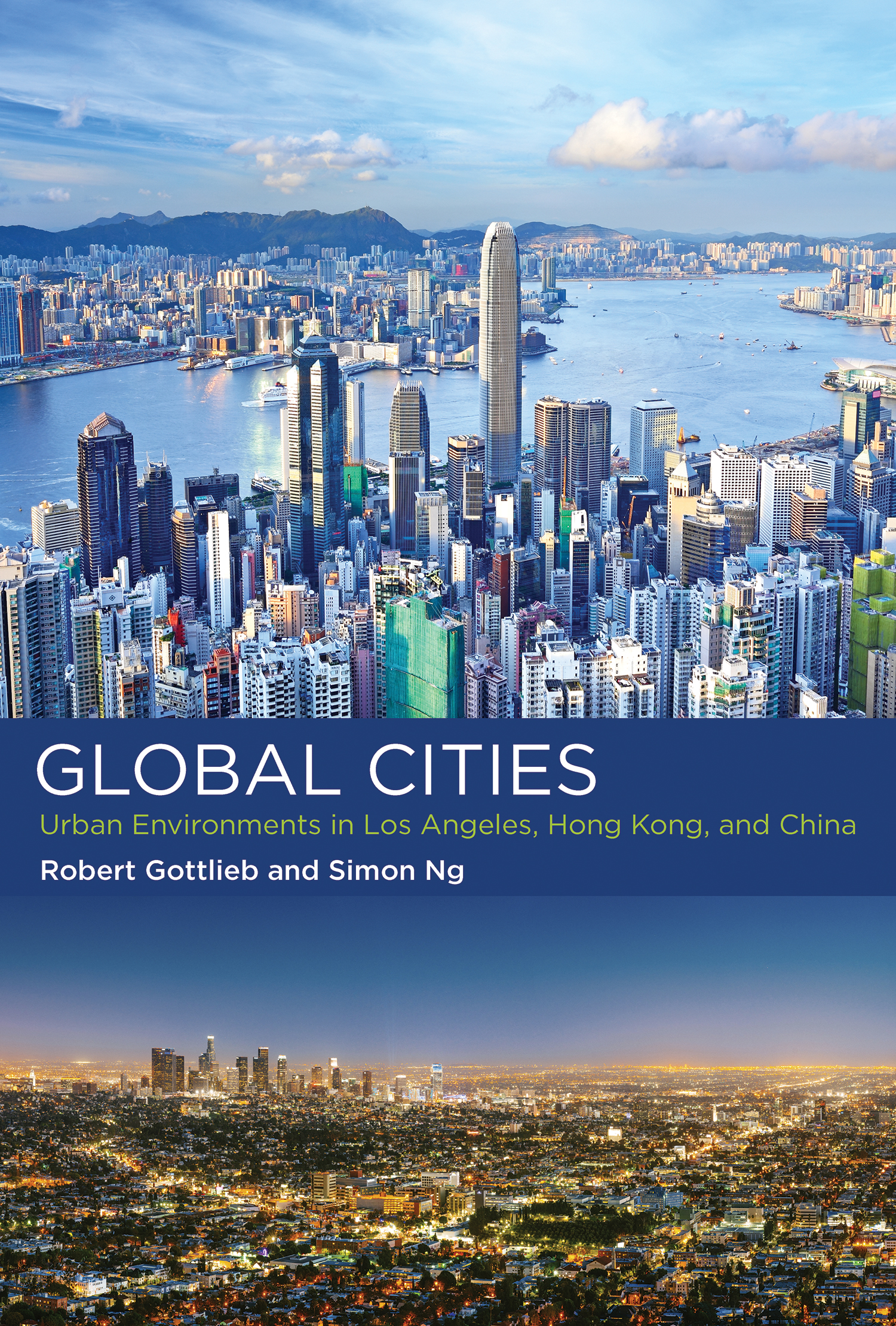Over the past four decades, Los Angeles, Hong Kong, and key urban regions of China have emerged as global cities—in financial, political, cultural, environmental, and demographic terms. In the new book, The Global Cities: Urban Environments in Los Angeles, Hong Kong, and China, Robert Gottlieb and Simon Ng trace the global emergence of these urban areas and compare their responses to a set of six urban environmental issues.

Robert Gottlieb
To consider the relevance of their book for food policy in New York City, CUNY Urban Food Policy Institute Research Director Nevin Cohen interviewed Robert Gottlieb, a co-author of the book, Professor Emeritus of Urban and Environmental Policy and founder and former Director of the Urban and Environmental Policy Institute at Occidental College. He is also the co-author with Anupama Joshi of Food Justice (2010).
Gottlieb, Robert; Ng, Simon. Global Cities: Urban Environments in Los Angeles, Hong Kong, and China Cambridge, MA: The MIT Press, 2017 www.globalcitiesbook.com
Your book emphasizes the importance of grassroots advocacy in LA, Hong Kong, and China, places with very different populations, histories, and political structures. What lessons can food advocates learn from LA, Hong Kong, and China?
We sought to compare and contrast Los Angeles and Hong Kong and their connection to China in six different areas of the urban environment, including their food systems. As urban places, food mostly comes from elsewhere. In Hong Kong, more than 95% of the food today is imported, including from the nearby province of Guangdong in China. Los Angeles once had a thriving agricultural system but as farming land gave way to urban and ex-urban development. By the 1940s and 1950s, Los Angeles became as dependent as any other US city on food from elsewhere. China, with its long rural farming traditions, has experienced a shift to an increasingly integrated form of capitalist agriculture with Chinese characteristics focused on the urban market.
In each of these places, a form of grassroots advocacy has emerged. In Los Angeles, a diverse food movement has focused on re-establishing and in some cases re-envisioning local and regional food growing and food production, with an especially effective Los Angeles Food Policy Council providing a kind of networking and “Big Tent” approach for grassroots advocacy. Hong Kong food groups have been strongly focused on food safety and, as with other urban environmental issues, how that relates to China. In China, there has also been a focus on food safety, with numerous scandals reflective of a changing food system and where abuses in growing and production have taken hold. China also has a historically rooted focus on communal and cooperative food growing and production. That approach has been revived through a “rural reconstruction” movement that today includes a new, Chinese version of Community Supported Agriculture (and a growing CSA Alliance) that connects the rural to the urban. In each of these places, grassroots advocacy seeks to identify a new (or renewed) connection to food grown and food consumed.
Advocates have used the “power of the public plate,” specifically LA’s good food purchasing policy, to improve how food is produced and distributed. Yet the case of Tyson chicken that you offer in the book illustrates how complex implementing a good food purchasing policy can be when the key suppliers are large global corporations like Tyson. What other strategies can advocates use to transform the global food system?
In my recent talks about our Global Cities book in Hong Kong, Shanghai, and Beijing, and now in the US, I’ve discussed the importance of the Good Food Purchasing Policy (which originated with the LA Food Policy Council and is now expanding nationally through the Center for Good Food Purchasing) as an important political moment for the food movement in the US. It also provides possible lessons for Hong Kong and China. The GFPP highlights two key goals for the food movement and for food system change. On the one hand, it provides a direct and structured framework for a value-based approach to food purchasing, and by extension to the selection of food providers. Its five sets of goals – a valued workforce, animal welfare, local food and local food economy, environment, and health and nutrition – are central to an agenda for food system change.

The Center for Good Food Purchasing transforms the way public institutions purchase food by creating a transparent and equitable food system built on five core values: local economies, health, valued workforce, animal welfare, and environmental sustainability.
At the same time, it provides a framework for cooperation and connected food advocacy among sometimes contending food advocates, e.g., environment and labor as one example. In the case of Tyson, which is both global (with a major presence in China) and also focused on the school food service market, its selection in 2010 by the Los Angeles Unified School District as the District’s chicken supplier (prior to the establishment of the GFPP) was a contentious political choice, precisely because of Tyson’s environmental and labor and animal welfare track record. The next year, as LAUSD prepared to switch its menu and begin to embrace a GFPP-framework, Tyson, due to its global supply chain priorities, failed to deliver any of its products during the first month of the school year, contributing to the chaos associated with the new school food menu choices. Yet LAUSD and a number of other school districts around the US have moved forward with new menus and new food purchasing strategies. In 2015-2016, as new contracts in LAUSD were developed, Tyson’s contract was ultimately not renewed. These were political moments that elevated the concept of a value-based approach.
There are obviously other approaches that also need to be developed when addressing strategies for global food system change but their common focus needs to be the assertion of those and other core values in reorienting how and where food is produced and consumed. That requires not just a social or environmental agenda but a political one that seeks to change local – and global – policies.
You point out that in Los Angeles and Hong Kong, many food advocates have focused on alternatives, from urban farms to organic CSAs. Have these efforts to create food alternatives helped or hindered more fundamental political and economic change?
That’s an important question since such alternatives have the capacity to identify a strategy for change but could also become a narrower route that leads to a niche market approach. That is the case in Los Angeles and Hong Kong and China where some organic farms have become linked and even captive to elite groups, such as government officials and wealthy businessmen. Linking these alternatives to “more fundamental political and economic change” requires a shift (or expansion) in three areas. These are: equity (i.e., expanding access to all, with affordability an important component); scale (influencing and entering broader markets and including greater numbers of participants along the food supply chain); and a more direct and robust link to social justice movements and goals. There are modest efforts along these lines. Farm to school (particularly, farm to public school) is one development that helps begin to answer both equity and scale questions. Food system change needs to be seen as part of a broader structural change through a social justice lens. Food is a health issue, a labor issue, an environmental issue, a climate change issue, and the list could go on. The connection and intersection of food and social justice movements – and agendas – is critical in that regard.
The book describes the rapid food transition underway in Hong Kong and China, with high rates of growth in away-from-home food spending and a corresponding rise in diet-related diseases. What can Hong Kong and China policymakers learn from the efforts to address overweight and obesity in LA?
Weight gain and obesity and their link to diet-related disease and health problems more broadly has become an increasing problem in Hong Kong and China in the past two decades. But those problems are still nowhere near the levels found in the US, including such health outcomes as diabetes. The food movement in the US has become increasingly focused on weight gain and diet-related health outcomes, both as part of its messaging and discourse, and through programs and initiatives. Public health advocates have also increasingly focused on diet and nutrition as an area of concern and also for policy intervention. There are increasing links between health and food advocates but it still remains relatively limited given the scale of the problems. That advocacy has helped, particularly with younger populations, but more in slowing the rate or slightly reducing the levels of weight gain and its companion health outcomes. The issue, by any means, has not been fully addressed.
However, in Hong Kong and China those concerns are only just beginning to be addressed. Often concerns about food safety tend to trump concerns about the need for healthier food. There is, however, some modest interest in how the US food movement has focused on these issues. In China, for example, there have been budding efforts to establish farm to school/healthy school food programs. This can be a promising area for food movements and activists to learn from each other across borders.
You note that food issues are “both global and local in origin and in how they are experienced.” One way to understand this tension and to articulate an alternative is through a food sovereignty lens. To what extent do food activists in LA and Hong Kong frame their issues as food sovereignty concerns? What would enable activists in both cities to ally with food sovereignty movements in the Global South?

The Coalition of Immokalee Workers (CIW) is a worker-based human rights organization built on a foundation of farmworker community organizing.
Not enough is being done along these lines. In the US, there had been efforts, through the now defunct Community Food Security Coalition, to make common cause with the food sovereignty groups, including Via Campesina. The late Kathy Ozer, an invaluable champion of food sovereignty in her role at the National Family Farm Coalition, played a key role in that regard. Several groups, notably the Coalition of Immokalee Workers, Grassroots International, and Food First, are champions of and connected to the food sovereignty approach. In Hong Kong and China, there have been budding efforts to identify with food sovereignty networks, including around GMO issues, but they are limited. One important change in this direction was the effort by China’s CSA Alliance (influenced in part by rural reconstruction ideas) to move toward a stronger focus on rebuilding rural communities. The next China CSA Alliance meeting will be in Guizhou Province in southwestern China, one of the poorest provinces in China with a long history of rural farming and also peasant exploitation and contemporary environmental degradation. The importance of reconnecting the rural to the urban, or, for the US food movement, the urban to the rural would be a key step in articulating a food sovereignty language and perspective.
The book discusses the challenges within a diverse city like LA of forging links among social change advocates across different racial, ethnic, and class boundaries. What do advocates need to do to be able to work across even larger geographic, political, and cultural borders to create alliances between, say, the US and China?
One of the interesting moments during my time in Beijing last month was a visit to the Shared Harvest CSA farm at the outskirts of Beijing. On the bulletin board was a sticker from the Community Alliance with Family Farmers. Later that day, a delegation from Slow Food (on the way to Slow Food International’s conference in Chengdu in southwestern China), including a group from the Navajo reservation came to the farm to find out more about it. Shi Yan, Shared Harvest’s founder, first developed a love of farming (and a CSA model) when she spent several months at a CSA farm in Minnesota! Creating alliances across borders is a crucial step for the US food movement which is sometimes too insular about its own perspective and framework.
You conclude by discussing the importance of place, and efforts by environmental and food movements to reclaim control over urban spaces. To what extent can local, often neighborhood-based efforts to improve quality of life, health, and equity also contribute to broader social and political change?
One of the most interesting cross-movement developments I’ve witnessed involves a Latino, largely immigrant neighborhood-based environmental justice group in the eastside of Los Angeles called East Yards Communities for Environmental Justice. East Yards had been primarily focused on air pollution and other community impacts from the ports and trucks and intermodal rail yards related to global trade and goods movement. As part of its advocacy, the group talked about the importance of place and what they hoped their community could develop as an alternative to the pollution they experienced from this goods movement system. And they came up with the idea of constructing raised bed gardens to improve healthy food access. From that initial experience, they talked about the need to develop an alternative framework around food for their community which suffered from lack of access to fresh, affordable, and healthy food. As a major environmental justice player, East Yard has been influential in creating that critical link between food and environment and community change and the group is at the forefront of creating a stronger social justice agenda for California.
